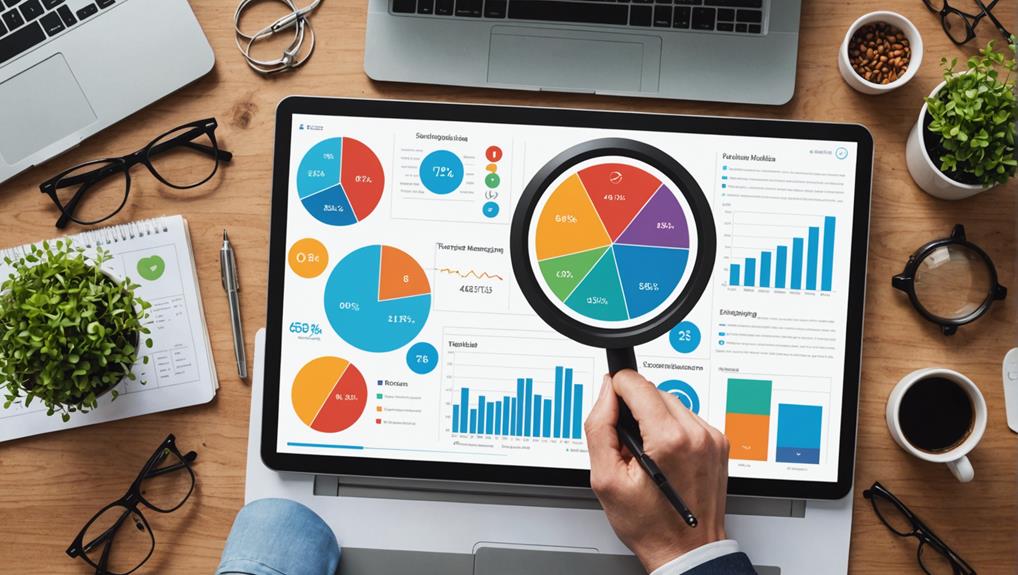You can drive social media growth by leveraging analytics to understand key metrics like engagement rate, reach, and click-through rate. Track audience behavior to refine your strategy based on interaction patterns and peak engagement times. Analyze content performance to identify what resonates most and tailor future posts accordingly. Monitor and compare engagement rates over time to adapt to evolving preferences. Utilize audience demographics to create targeted, high-impact content. Finally, set data-driven goals aligned with measurable KPIs to guide your efforts. Implementing these strategies guarantees your social media presence grows effectively and sustainably. Ready to boost your strategy further?
Key Takeaways
- Track engagement metrics to refine content strategies and boost audience interaction.
- Analyze audience demographics to tailor content and enhance targeted messaging.
- Monitor follower growth and post engagement to gauge content performance.
- Use A/B testing to identify top-performing content themes and optimize impact.
- Leverage click-through rates to assess the effectiveness of call-to-actions and ads.
Understanding Social Media Metrics
To drive social media growth effectively, you need to understand key metrics like engagement rate, reach, impressions, and click-through rate. These metrics are vital for evaluating content performance and audience interactions. By focusing on performance measurement, you can determine how well your content is resonating with your audience.
Engagement rate, for example, indicates how actively your followers are interacting with your posts, while reach measures the number of unique users who've seen your content.
Regular data analysis is essential in this situation. Monitoring metrics like follower growth and post engagement consistently enables you to make informed, data-driven decisions. For instance, a high click-through rate suggests that your call-to-actions are compelling, driving users to take desired actions. Conversely, low engagement rates may indicate the need for content strategy adjustments.
Utilizing analytics tools can provide detailed insights into these social media performance metrics. These tools help you track and analyze the data efficiently, ensuring you're always aware of your social media performance. By leveraging data analysis, you can continually refine your strategies, leading to sustained social media growth and more effective audience engagement.
Tracking Audience Behavior
To effectively track audience behavior, you should analyze engagement patterns and content interaction trends.
By monitoring metrics like engagement rate and click-through rate, you can gain insights into what resonates with your audience.
Use this data to refine your strategies and optimize your content for maximum impact.
Engagement Patterns Analysis
By closely analyzing audience behavior patterns, you can pinpoint peak engagement times and content preferences, driving a more effective social media strategy. Understanding when your audience is most active and what types of posts they interact with can greatly enhance your platform's performance.
Tracking key metrics like likes, comments, and shares allows you to see which posts resonate most with your audience. Additionally, analyzing reach, impressions, and click-through rates provides deeper insights into what content is not only viewed but acted upon. This data helps in refining your posting schedule and tailoring content to fit audience preferences.
Here's a breakdown of critical metrics you should track:
| Metric | Purpose | Actionable Insight |
|---|---|---|
| Likes | Measures content popularity | Identify high-performing content |
| Comments | Gauges audience engagement | Foster community with engaging content |
| Shares | Indicates content virality | Create shareable posts |
| Reach | Number of unique viewers | Optimize post timing |
| Click-through Rate | Measures interaction with links | Improve call-to-action effectiveness |
Content Interaction Trends
Analyzing content interaction trends allows you to strategically tailor your posts based on how your audience engages with different types of content. By examining engagement rates, you gain audience insights that drive your engagement strategies. Focus on likes, comments, and shares to understand what captivates your followers. Content optimization starts with tracking post reach and impressions to identify which posts resonate best and contribute to your growth tactics.
Monitoring click-through rates (CTR) is essential for evaluating the effectiveness of your call-to-actions (CTAs). A higher CTR indicates that your audience finds your CTAs compelling, helping you refine your content for better conversions. Identifying peak posting times by analyzing audience activity ensures that your content reaches the maximum number of users, increasing the likelihood of engagement.
Experimentation through A/B testing can't be overlooked. Test different variables like headlines, visuals, and CTAs to see which combinations drive the most interaction. This method provides concrete data to fine-tune your approach, making sure every post is optimized for maximum impact.
Analyzing Content Performance
Start by examining post engagement metrics like likes, comments, and shares to pinpoint your top-performing content. This initial step in engagement optimization is important for refining your content strategy. By evaluating these metrics, you can identify which types of posts resonate most with your audience. Performance evaluation helps you understand what drives engagement, allowing you to pivot your content efforts accordingly.
Track audience reach and impressions to gauge the visibility of your posts. Higher reach and impressions indicate that your content is being seen by more people, which is a good sign of effective content distribution. Utilize audience insights to tailor your posts to what your followers find most appealing. Understanding these metrics will inform your strategy, ensuring you're not just creating content, but creating content that matters.
Next, measure the growth rate of your followers to see how your content is contributing to audience expansion. Use click-through rate data to determine which posts generate the most interest and engagement. A/B test different content themes to discover what resonates best with your audience, fine-tuning your approach based on tangible data. This strategic analysis will drive sustained social media growth.
Measuring Engagement Rates
Calculating your engagement rate gives you a clear picture of how effectively your content is connecting with your audience. To do this, divide your total engagement (likes, comments, shares) by your total reach and multiply by 100. This metric is essential in understanding the strength of your content strategy and how well it resonates with your followers.
By monitoring engagement rates, you can identify which types of posts generate the most interaction. This insight is vital for engagement rate optimization, enabling you to refine your content strategy.
You should also compare your engagement rates against industry engagement benchmarks and perform competitor analysis to see how you stack up. This will help you set realistic goals and identify potential areas for improvement.
Analyzing changes in engagement rates over time can reveal evolving audience preferences and emerging trends. This data-driven approach allows you to adapt your strategy proactively.
A higher engagement rate leads to increased brand visibility, loyalty, and even potential virality, driving your social media growth. By consistently optimizing your engagement rates, you can make sure that your content not only reaches but also effectively engages your target audience.
Leveraging Audience Demographics
Understanding how your content resonates is only part of the equation; knowing who your audience is can greatly enhance your social media growth. Analyzing audience demographics gives you insights into age, gender, location, and interests of your followers. This data is invaluable for crafting targeted messaging that speaks directly to the specific needs and preferences of your audience.
For instance, if your demographic analysis reveals a significant number of followers from a particular age group or geographical location, you can tailor your content accordingly. Personalized strategies like these enhance engagement and make your audience feel understood and valued. They're more likely to interact with your posts, share them, and even convert into customers.
Moreover, data on device preferences and industry-related topics allows you to fine-tune your campaigns for optimal resonance. If most of your audience accesses your content via mobile devices, make sure your posts are mobile-friendly.
Leveraging audience demographics doesn't just stop at content creation; it also extends to ad targeting. By understanding who your audience is, you can optimize your ads to reach the right people, thereby boosting engagement rates and increasing conversion rates.
Setting Data-Driven Goals
To set effective data-driven goals, you need to define key performance indicators (KPIs) that reflect your social media objectives. Establish measurable objectives, such as increasing click-through rates by 15%, to guarantee your efforts are trackable.
Align these goals with your metrics, allowing you to evaluate success and adjust strategies for maximum growth.
Define Key Performance Indicators
To effectively measure and enhance your social media performance, you must establish key performance indicators (KPIs) that align with your business objectives. KPIs are specific metrics used to evaluate the success of your social media efforts. By setting data-driven goals based on these KPIs, you can track your progress and measure the effectiveness of your strategies.
Start by identifying KPIs that matter most to your business. Common examples include engagement rate, reach, click-through rate, conversion rate, and follower growth. These metrics will serve as the foundation for your performance evaluation, enabling you to conduct a metric comparison against your goals and competitors.
Data-driven goals make sure that your social media activities aren't just random acts but are strategically aligned with your business objectives. Regularly monitoring these KPIs allows you to make informed adjustments to your strategies, driving continuous improvement and growth.
Establish Measurable Objectives
Crafting measurable objectives is essential for harnessing the power of analytics to propel your social media growth. You need to set clear, data-driven goals to effectively track your progress and optimize your strategies. When your objectives are specific, measurable, achievable, relevant, and time-bound (SMART), you can better understand what works and what doesn't on your social media platforms.
Start by defining what you want to achieve. Is it more followers? Higher engagement rates? Increased website traffic from social media? Once you know your goals, you can use analytics to track your progress and make necessary adjustments.
Here's a helpful table to outline SMART goals for social media:
| Goal Setting | Progress Tracking |
|---|---|
| Increase followers | Track weekly follower growth |
| Boost engagement | Monitor likes, shares, comments |
| Drive website traffic | Measure click-through rates |
| Enhance brand awareness | Analyze reach and impressions |
These measurable objectives will help you identify areas needing improvement and focus your efforts where they'll have the most impact. By regularly reviewing your progress against these specific goals, you can make strategic decisions that drive sustained social media growth. Remember, your goals should always be guided by data insights to make sure you're on the right path.
Align Goals With Metrics
Aligning your social media goals with specific metrics guarantees you can accurately measure success and fine-tune your strategies for maximum growth. Metric alignment is essential in creating data-driven goals that allow you to track progress effectively. By tying specific metrics such as engagement rate, reach, and conversions to each goal, you establish clarity and accountability in your social media efforts.
Incorporating goal measurement into your strategy means you can identify which areas need improvement and optimize your approach accordingly. For instance, if your goal is to increase brand awareness, tracking metrics like reach and impressions will help you determine if your content is being seen by a broader audience.
On the other hand, if your goal is to boost engagement, focusing on metrics such as likes, comments, and shares will provide insight into how your audience is interacting with your content. Setting data-driven goals enables you to measure the effectiveness of your campaigns, ensuring that your efforts are focused on achieving tangible results.
Utilizing Analytics Tools
Leveraging social media analytics tools like Sprout Social, Hootsuite, and Google Analytics can transform your content strategy by providing critical insights into audience behavior and engagement metrics. These tools help you understand who your audience is, what they engage with, and how they interact with your content.
To optimize conversion, you need to focus on metrics like click-through rates, conversion rates, and bounce rates. Knowing which posts drive the most traffic to your website enables you to tweak your strategy for maximum impact. Additionally, identifying top-performing content can guide your influencer partnerships, making sure you're collaborating with those who align with your brand and audience.
Here's a quick comparison of essential features across these tools:
| Feature | Sprout Social | Hootsuite | Google Analytics |
|---|---|---|---|
| Audience Demographics | Yes | Yes | Yes |
| Engagement Metrics | Yes | Yes | Yes |
| Website Traffic Analysis | Limited | Limited | Thorough |
| Sentiment Analysis | Yes | Yes | No |
| ROI Tracking | Yes | Yes | Yes |
Utilizing these analytics tools is crucial for making data-driven decisions, improving social media effectiveness, and staying ahead in the digital landscape. By continuously refining your tactics and monitoring competitor activity, you can guarantee sustained growth and enhanced ROI.
Frequently Asked Questions
How to Use Analytics for Social Media?
To use analytics for social media, track engagement metrics to see what resonates. Analyze data for content optimization, refining strategies to boost reach and impact. Tailor content based on insights, ensuring strategic growth and maximum engagement.
How Do You Analyze Social Media Growth?
Analyze social media growth by examining follower demographics and tracking your engagement rate. Use analytics tools to identify trends, measure the effectiveness of your content, and compare your metrics against industry benchmarks for strategic adjustments.
How Do You Drive Social Media Growth?
You drive social media growth by refining your content strategy and collaborating with influencers. Focus on engaging themes, track audience behaviors, and consistently analyze metrics. This data-driven approach guarantees your content resonates and amplifies your reach.
What Are the Benefits of Using Social Media Analytics?
You gain valuable audience insights and track performance metrics, helping you target specific groups, optimize content, and measure ROI. Analytics tools also allow strategic adjustments by comparing competitor performance and enhancing brand perception through sentiment analysis.
Conclusion
To drive your social media growth, you need to harness the power of analytics. By understanding key metrics, tracking audience behavior, and analyzing content performance, you'll gain strategic insights.
Measure engagement rates and leverage audience demographics to tailor your approach. Set data-driven goals and utilize analytics tools to stay ahead.
With these strategies, you'll turn data into actionable insights, ensuring your social media efforts yield tangible results.




